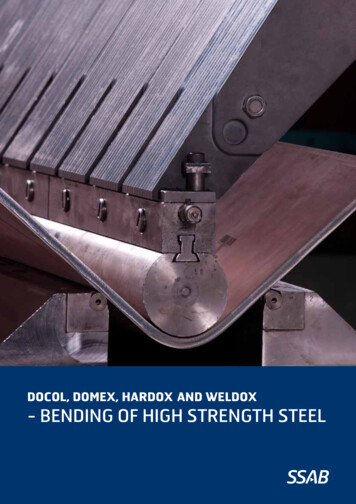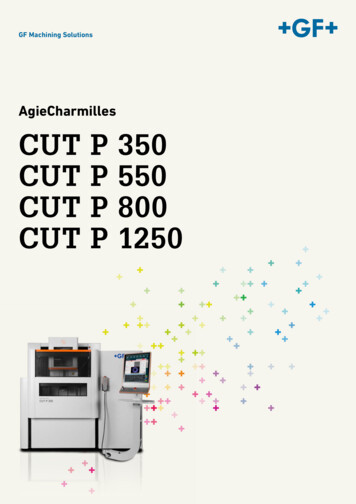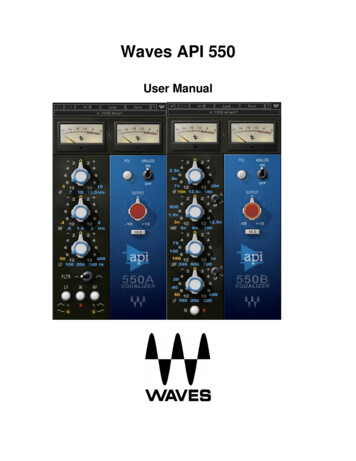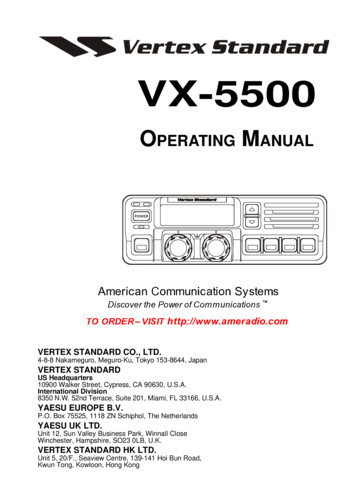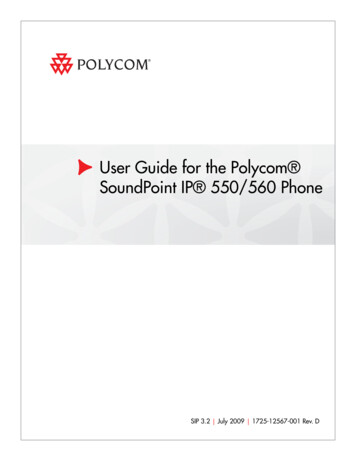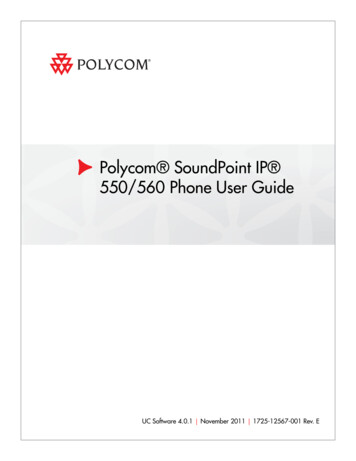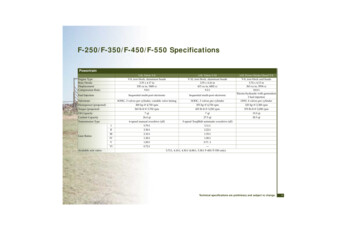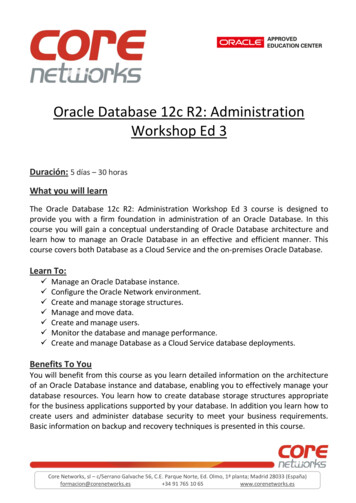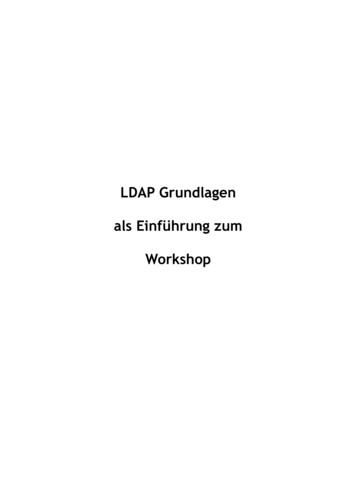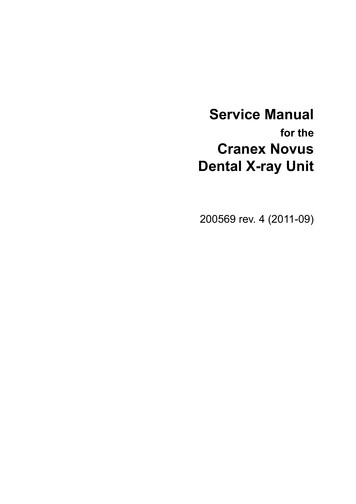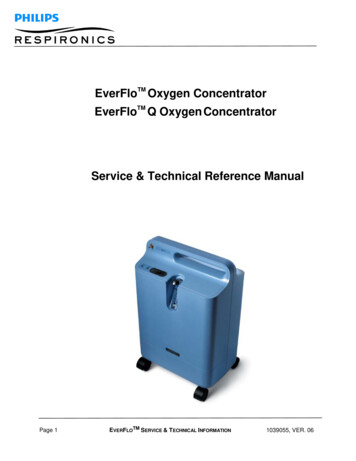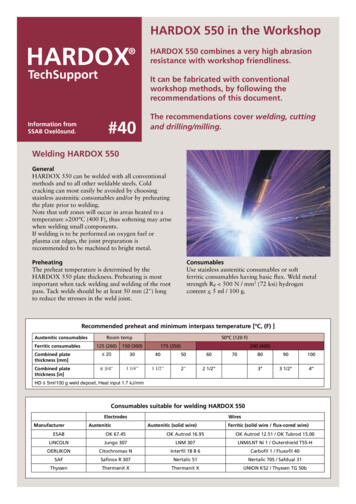
Transcription
HARDOX 550 in the WorkshopHARDOX 550 combines a very high abrasionresistance with workshop friendliness.It can be fabricated with conventionalworkshop methods, by following therecommendations of this document.The recommendations cover welding, cuttingand drilling/milling.Welding HARDOX 550GeneralHARDOX 550 can be welded with all conventionalmethods and to all other weldable steels. Coldcracking can most easily be avoided by choosingstainless austenitic consumables and/or by preheatingthe plate prior to welding.Note that soft zones will occur in areas heated to atemperature 200 C (400 F), thus softening may arisewhen welding small components.If welding is to be performed on oxygen fuel orplasma cut edges, the joint preparation isrecommended to be machined to bright metal.PreheatingThe preheat temperature is determined by theHARDOX 550 plate thickness. Preheating is mostimportant when tack welding and welding of the rootpass. Tack welds should be at least 50 mm (2’’) longto reduce the stresses in the weld joint.ConsumablesUse stainless austenitic consumables or softferritic consumables having basic flux. Weld metalstrength Re 500 N / mm2 (72 ksi) hydrogencontent 5 ml / 100 g.Recommended preheat and minimum interpass temperature [ºC, (F) ]Austenitic consumablesRoom temp50ºC (120 F)125 (260)150 (300)Combined platethickness [mm] 2030405060Combined platethickness [in] 3/4’’1 1/4’’1 1/2’’2’’2 1/2’’Ferritic consumables175 (350)200 (400)7080901003’’3 1/2’’4’’HD 5ml/100 g weld deposit, Heat input 1.7 kJ/mmConsumables suitable for welding HARDOX 550ElectrodesManufacturerAusteniticWiresAustenitic (solid wire)Ferritic (solid wire / flux-cored wire)ESABOK 67.45OK Autrod 16.95OK Autrod 12.51 / OK Tubrod 15.00LINCOLNJungo 307LNM 307LNM/LNT Ni 1 / Outershield T55-HOERLIKONCitochromax NInterfil 18 8 6Carbofil 1 / Fluxofil 40SAFSafinox R 307Nertalic 51Nertalic 70S / Safdual 31ThyssenThermanit XThermanit XUNION K52 / Thyssen TG 50b
Cutting HARDOX 550Thermal cuttingTable 1.Preheat recommendations foroxygen fuel cutting of HARDOX 550Thickness [mm (in)]Temperatur [ C (F)] 20 mm ( 3/4’’)No preaheating20 - 30 mm (3/4’’ - 1 1/4’’)100 C (200)30.1 - 50 mm (1 1/4’’-2’’)150 C (300)Table 2.Maximum recommended cutting speed for Oxygen fuelcutting of HARDOX 550, if no preheating is employed.Slow cutting / Submerged cuttingThickness[mm (in)]Max cutting speed[mm/min (in/min)] 20 (3/4’’)no restriction25 (1’’)270 (11)30 (1 1/4’’)230 (9)3519040 (1 1/2’’)160 (6)45 * (1 3/4’’)140 (5.5)50 * (2’’)130 (5)*When using cutting speeds 140 mm/min (5.5 in/min) thetendency for developing a poor cut edge quality becomesevident, therefore attention must be paid when 1) selectingthe cutting nozzle and 2) selecting the cutting gas pressure.1) The nozzle should be selected according to the platethickness. The use of high efficiency or high speed nozzles hasproven to give a better edge quality then standard nozzles.2) Try to reach a state of best performance by adjusting thecutting gas pressure.Submerged cuttingGeneral guidelines for cuttingAllow a cold plate to reach room temperature beforethermal cutting.For demanding applications, in 40 – 50 mm(1 1/2’’ - 2’’) plate thickness, it is recommended toperform ultrasonic inspection of the cut edge, not lessthan two weeks after cutting.Preheating for Oxy fuel cuttingThe best way to avoid cut edge cracking when oxygenfuel cutting is to use preheating. The preheating can beperformed by the use of burner lances, electrical heatingmats or by furnace tempering. The recommendedpreheat temperatures for HARDOX 550 are given intable 1. No restriction on cutting speed is required.Slow cutting speed when Oxy fuel cuttingAn alternative to preheating prior to cutting is to reducethe cutting speed. The heat accumulated in the plateduring the cutting process will then act as a kind ofpreheating. Cutting at a low cutting speed has, however,shown to be less reliable than the use of preheatingfor preventing cut edge cracking. If preheating is notemployed, the maximum permissible cutting speed isgiven in table 2. The lower the cutting speed used, theless the risk for cut edge cracking.Slow cooling when Oxy fuel cuttingRegardless of whether preheating or slow cuttingspeeds are employed, a slow cooling rate of the cutpart will reduce the risk for cut edge cracking. Slowcooling rate can be achieved if the parts are stackedtogether while still warm and covered with an insulatingblanket. Allow the parts to cool slowly down to roomtemperature.
Fig. 1.Hardness vs Tempering temperatureHARDOX 550650600Hardness, HBWCutting of small components withOxy fuel cuttingTo gain full benefit from the plate hardness it isimportant to consider the hardness reduction due totempering by preheating and the heat generated fromthe cutting. In figure 1 the reduction in hardness dueto tempering temperature is shown. The smallerthe size of the cut part, the greater the probability forsoftening.By “small components” we mean when the distancebetween two individual cuts is less then 200 mm (8’’).The best way to prevent softening of smallcomponents is to perform cutting submerged inwater* or to choose another cutting method wherethe amount of heat generated is limited, like laser orabrasive water jet cutting.Abrasive Water Jet cuttingAbrasive water jet cutting (AWJ) is an excellentmethod for cutting HARDOX 550. The method ishighly recommended when cutting thicker gauges.The use of AWJ produces narrow tolerances, no heataffected zone and an excellent cut edge quality.Plasma CuttingPlasma cutting can be performed up to a platethickness of 20 mm (3/4’’), in air as well as submergedin water. There is no need for preheating, and there areno restrictions on cutting speed.Laser CuttingLaser cutting can be performed up to a plate thicknessof 20 mm (3/4’’), without restrictions on cutting speed.500450400100200200400300570400 ºC750 FTempering temperatureFig. 2.Surface hardness when oxy fuel cuttingt 50 mm/cutting speed 110 mm/min650550500Hardness, HBWMinimize HAZ softeningThe width of the softened HAZ is minimized ifthermal cutting is performed submerged in water*.Figure 2 displays the extension of the heat affectedzone (HAZ) from oxy fuel cutting in air andsubmerged in water.550450400350In airSubmerged in water30025001020Distance from cut edge (mm)* Cutting speeds for submerged oxy-fuel cutting arethe same as for slow cutting, table 2.Stud welding HARDOX 550General information on stud weldingHARDOX 550 can be stud welded with ordinary CMn bolts. The most important thing is to avoidhydrogen cracking. This can be done by welding thebolts to a ground, clean and dry surface. If delayedfracture of the bolts in the weldzone should occurpost heating is recommended as a remedy.Post heating is performed by heating the bolt until itis almost completely orange in colour. This takesabout 15-20 seconds of heating for M12. If the platethickness is less than 15 mm (5/8’’) only heat theupper half of the bolt.If possible, measure the plate temperature on theopposite side of the bolt. The plate should not getwarmer than 200ºC (400 F).PostheatingDue to manyparameters there area large number ofweld setupcombinations.Therefore, it isadvisable to contactour TechnicalCustomer ServiceDepartment forfurther information.This document contains general suggestions and calculation models. SSAB Oxelösund AB hereby disclaims any liability for their suitability forindividual applications. It is the responsibility of the user of the document to adapt the recommendations contained therein to the requirements ofindividual applications
Machining HARDOX 550HARDOX 550 can be machined in ordinary stable machines. It is important to avoidvibrations and to use proper tools of the cemented carbide type.DrillingOnly use cemented carbide type of drills. Provide an abundant supply of coolant.Recommended data for drillingToolCutting speed Vc[m/min (in/min)]Feed rate, f[mm/rev (in/rev)]Solid cemented carbide20–30 (800-1200)0.07–0.11 (0.003-0.004)Brazed cemented carbide20–30 (800-1200)0.07–0.11 (0.003-0.004)Indexable inserts35–50 (1400-2000)0.05–0.11 (0.002-0.004)MillingOnly milling cutters with cemented carbides inserts are recommended.Recommendations for face and square shoulder millingFACE AND SQUARE SHOULDER MILLINGCoated cemented carbide inserts of ISO class K20Feed [mm/tooth (in/tooth)]Cutting speed [m/min (in/min)]0.07 (0.003)80 (3100)0.1 (0.004)75 (3000)0.2 (0.008)70 (2800)Counterboring and countersinkingSpot facing and countersinking of HARDOX 550 is performed with tools having cementedcarbide inserts and a revolving pilot. Apply coolant.Recommended process parametersProcessCutting speed[m/min (in/min)]Feed Rate[mm/rev (in/rev)]Counterboring15–50 (600-2000)0.10–0.20 (0.004-0.008)Countersinking10–35 (400-1400)0.07–0.14 (0.003-0.006)Tapping and threadingHARDOX 550 is too strong for tapping tools. If threads are desired they have to be made ina numerically controlled machine with a thread milling tool of the cemented carbide type. Thecutting speed should be approximately 30 m/min (1200 in/min).
Bending HARDOX 550Our Technical Support will provide information on request.SSAB Oxelösund ABSE-613 80 OxelösundSwedenPhone 46 155 25 40 00Fax 46 155 25 40 73www.ssabox.comwww.hardox.comThe UK English version of this document shall prevail in case of discrepancy. Download the latest version from www.ssabox.com/publicationsThis brochure contains general suggestions. SSAB Oxelösund AB hereby expressly disclaims any liability for their suitability for individual applications. It is the responsibility of the user of the brochure to adapt the recomendations contained therein to the requirements of individual applications.TS-40-hx 550 in the workshop-uk-v1-2004HARDOX wear plate only from SSAB OxelösundHARDOX is a registered trademark of SSAB Oxelösund.
Consumables suitable for welding HARDOX 550 HARDOX 550 in the Workshop HARDOX 550 combines a very high abrasion resistance with workshop friendliness. It can be fabricated with conventional workshop methods, by following the recommendations of this document. The recommendations cover welding, cutting and drilling/milling.
